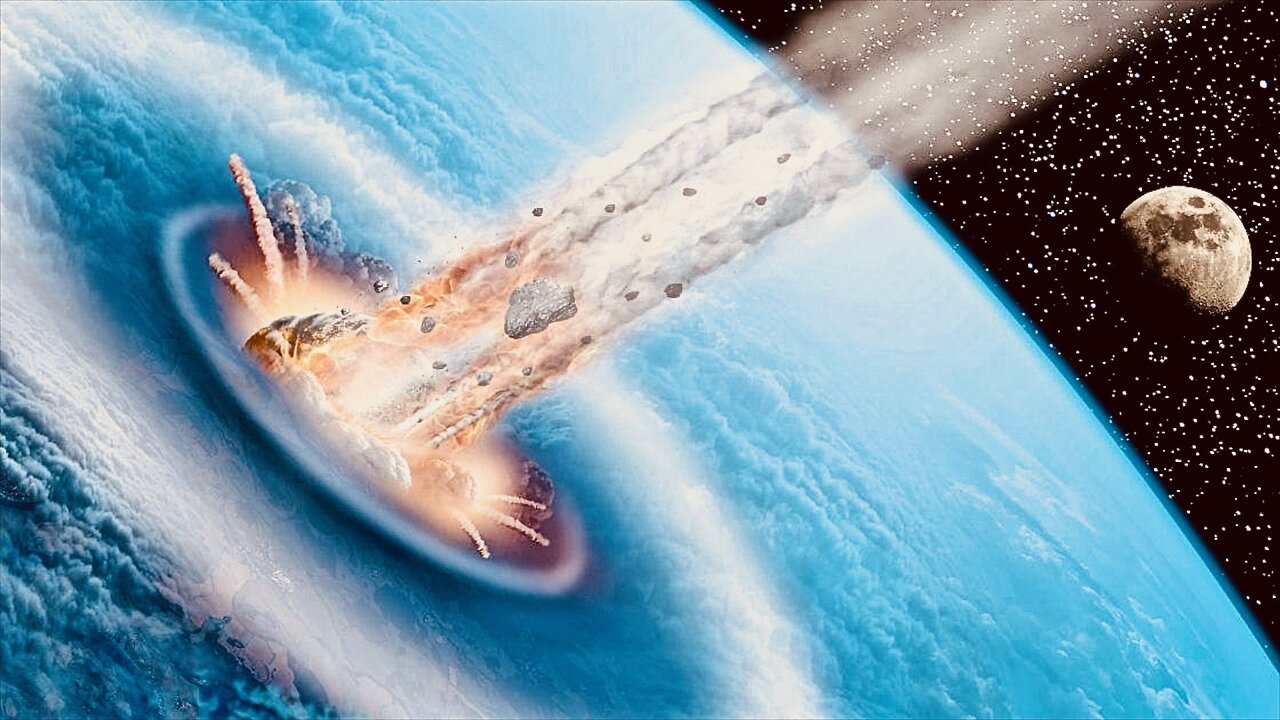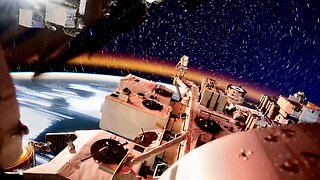Premium Only Content

Anatomy of an Ocean Asteroid Strike
Massive tsunami sweeps Atlantic Coast in asteroid impact scenario for March 16, 2880 - If an asteroid crashes into the Earth, it is likely to splash down somewhere in the oceans that cover 70 percent of the planet's surface. Huge tsunami waves, spreading out from the impact site like the ripples from a rock tossed into a pond, would inundate heavily populated coastal areas. A computer simulation of an asteroid impact tsunami developed by scientists at the University of California, Santa Cruz, shows waves as high as 400 feet sweeping onto the Atlantic Coast of the United States.
The researchers based their simulation on a real asteroid known to be on course for a close encounter with Earth eight centuries from now. Steven Ward, a researcher at the Institute of Geophysics and Planetary Physics at UCSC, and Erik Asphaug, an associate professor of Earth sciences, report their findings in the June issue of the Geophysical Journal International.
March 16, 2880, is the day the asteroid known as 1950 DA, a huge rock two-thirds of a mile in diameter, is due to swing so close to Earth it could slam into the Atlantic Ocean at 38,000 miles per hour. The probability of a direct hit is pretty small, but over the long timescales of Earth's history, asteroids this size and larger have periodically hammered the planet, sometimes with calamitous effects. The so-called K/T impact, for example, ended the age of the dinosaurs 65 million years ago.
"From a geologic perspective, events like this have happened many times in the past. Asteroids the size of 1950 DA have probably struck the Earth about 600 times since the age of the dinosaurs," Ward said.
Ward and Asphaug's study is part of a general effort to conduct a rational assessment of asteroid impact hazards. Asphaug, who organized a NASA-sponsored scientific workshop on asteroids last year, noted that asteroid risks are interesting because the probabilities are so small while the potential consequences are enormous. Furthermore, the laws of orbital mechanics make it possible for scientists to predict an impact if they are able to detect the asteroid in advance.
"It's like knowing the exact time when Mount Shasta will erupt," Asphaug said. "The way to deal with any natural hazard is to improve our knowledge base, so we can turn the kind of human fear that gets played on in the movies into something that we have a handle on."
Another study says - It won’t be a tsunami. Nor an earthquake. Not even the crushing impact of the space rock. No, if an asteroid kills you, gusting winds and shock waves from falling and exploding space rocks will most likely be to blame. That’s one of the conclusions of a recent computer simulation effort that investigated the fatality risks of more than a million possible asteroid impacts.
In one extreme scenario, a simulated 200-meter-wide space rock whizzing 20 kilometers per second whacked London, killing more than 8.7 million people. Nearly three-quarters of that doomsday scenario’s lethality came from winds and shock waves, planetary scientist Clemens Rumpf and colleagues report online March 27 in Meteoritics & Planetary Science.
Music: Into The Heat by Dhruva Aliman
Amazon - https://amzn.to/3eyYxeD
https://music.apple.com/us/artist/dhruva-aliman/363563637
https://dhruvaaliman.bandcamp.com/album/king-neptunes-travelling-merchants-and-their-adventures-in-and-beyond-the-sea
http://www.dhruvaaliman.com/
Spotify - https://open.spotify.com/artist/5XiFCr9iBKE6Cupltgnlet
-
 3:12
3:12
Seeker Land
1 month agoInteresting Experiments On ISS - International Space Station
1131 -
 LIVE
LIVE
Savanah Hernandez
5 hours agoRogue Judges Continue Blocking Trump's Executive Orders: The First 100 Days
10,277 watching -
 58:42
58:42
Coin Stories with Natalie Brunell
12 hours agoMacro Analysis, Financial Fragility and Bitcoin as the End Game with Preston Pysh
412 -
 2:35:37
2:35:37
TimcastIRL
3 hours agoTrump Celebrates 100 Days Amid RECORD Lawsuits & Unconstitutional Judicial Actions | Timcast IRL
131K58 -
 1:01:26
1:01:26
Glenn Greenwald
4 hours agoRapid Fire: Canada Elections, Dem's Sit-In, Israeli Taking Points Escalate; PLUS: Jewish Academics Push-Back on Antisemitism Claims | SYSTEM UPDATE #445
84.6K87 -
 DVR
DVR
RiftTV/Slightly Offensive
3 hours ago $4.20 earnedTotal Indian TAKEOVER: Has The WEST Completely FALLEN? | Guest: Josh Denny
18.1K10 -
 9:46
9:46
Mrgunsngear
3 hours ago $4.66 earnedHow To Turn Your Glock Into A PCC
23.4K6 -
 16:12
16:12
T-SPLY
11 hours agoJeff Bezos Is Now Enemy #1 For The Trump Administration
86.1K70 -
 12:24
12:24
Tundra Tactical
4 hours ago $1.38 earnedThe SIG Roast to ND Them All
33.1K7 -
 1:02:31
1:02:31
BonginoReport
7 hours agoDeportations Keep “Frightened” Michelle Obama Awake at Night (Ep. 37) - Nightly Scroll with Hayley
115K161